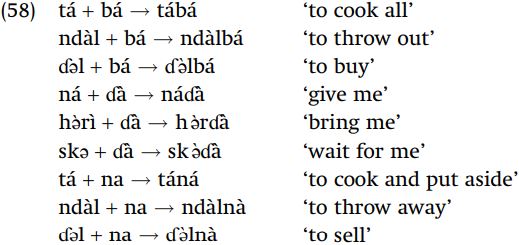
Toneless vowels
 المؤلف:
David Odden
المؤلف:
David Odden
 المصدر:
Introducing Phonology
المصدر:
Introducing Phonology
 الجزء والصفحة:
302-9
الجزء والصفحة:
302-9
 14-4-2022
14-4-2022
 1536
1536
Toneless vowels
Another phenomenon demonstrating the independence of tones and vowels is the existence of underlyingly toneless vowels. This can be illustrated with data from Margyi. There are two tones in Margyi, H and L, but there are three underlying types of vowels in terms of tonal behavior, namely H, L, and toneless. Examples of underlyingly toneless morphemes are /ɗəl/ ‘buy,’ /skə/ ‘wait,’ and /na/ ‘away.’ When two morphemes with underlying tones are combined, there are no surface tone changes. However, when one of the toneless morphemes is combined with a morpheme with tone, the toneless morpheme takes on the tone of the tone-bearing morpheme.

As (59) indicates, this can be accounted for by spreading tone (i.e. adding associations between tone and vowels) to toneless vowels.

The form ɗə̀ l-nà ‘to sell,’ which combines two toneless morphemes, illustrates another property of tone systems. Since all vowels must on the surface have some tonal specification, the following question arises: if there is no tone present in the string which could spread to toneless vowels, how do toneless vowels get their surface tone? The answer is that there are also rules of default tone assignment, which guarantee that if a vowel does not otherwise have a tone value, one is automatically assigned. Such a rule can be formalized as (60).

Generally, in languages with two levels of tone, the default value assigned to otherwise toneless vowels is L; in languages with three tone levels, the default tone specification is usually M tone. Yoruba is a language with three tone levels, where it can be argued that M-toned vowels are actually underlyingly toneless, and M tones are assigned by a default tone-assignment rule. The examples in (61) illustrate a very general tone-spreading rule whereby L tone becomes falling after H, and H tone becomes rising after L. However, M is unchanged after either L or H, and M also has no effect on a following L or H.

The question is how to exclude M tone from being targeted by this rule, and how to prevent M tone from spreading. If we assume that tonally unspecified vowels are assigned an M tone by default, and that M tones in Yoruba derive only from application of this default specification rule, then we can explain these patterns rather simply. We can assume the following tone-spreading rule, where T represents any tone.

The fact that contours are not formed with M tone follows from the fact that a contour is two tone specifications on one vowel, plus the hypothesis that M tone is only assigned if there is no tonal specification on a vowel.
 الاكثر قراءة في Phonology
الاكثر قراءة في Phonology
 اخر الاخبار
اخر الاخبار
اخبار العتبة العباسية المقدسة


